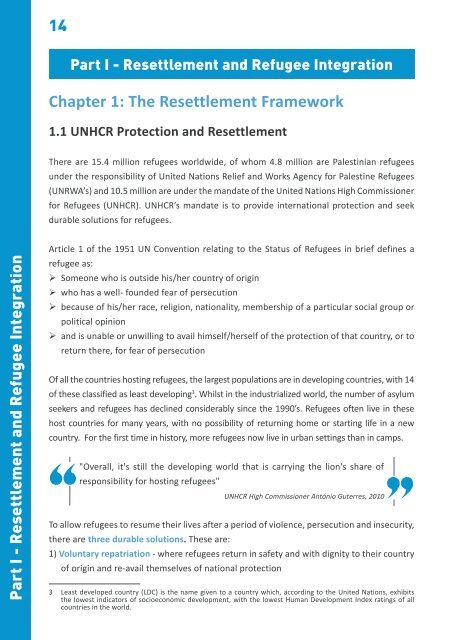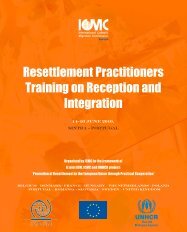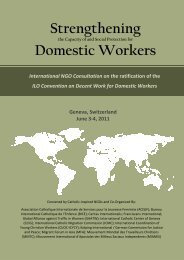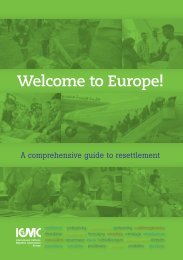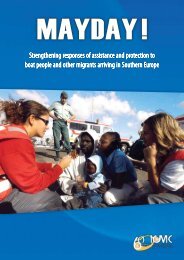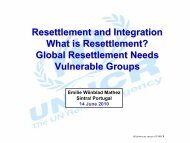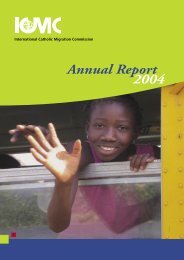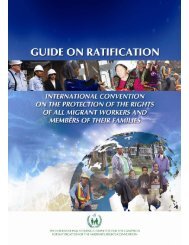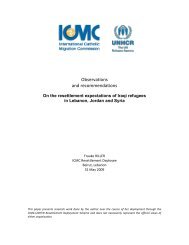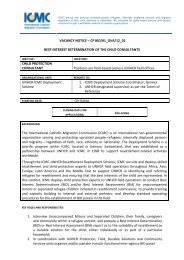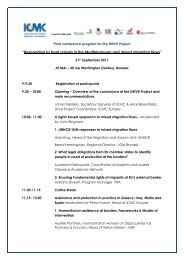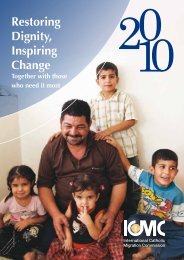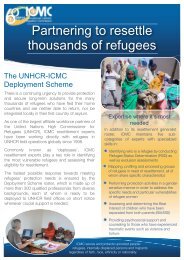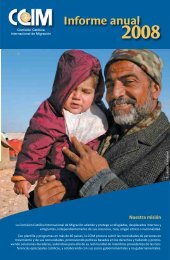'Paving the Way' Handbook - ICMC
'Paving the Way' Handbook - ICMC
'Paving the Way' Handbook - ICMC
Create successful ePaper yourself
Turn your PDF publications into a flip-book with our unique Google optimized e-Paper software.
14<br />
Part I - Resettlement and Refugee Integration<br />
Chapter 1: The Resettlement Framework<br />
1.1 UNHCR Protection and Resettlement<br />
There are 15.4 million refugees worldwide, of whom 4.8 million are Palestinian refugees<br />
under <strong>the</strong> responsibility of United Nations Relief and Works Agency for Palestine Refugees<br />
(UNRWA’s) and 10.5 million are under <strong>the</strong> mandate of <strong>the</strong> United Nations High Commissioner<br />
for Refugees (UNHCR). UNHCR’s mandate is to provide international protection and seek<br />
durable solutions for refugees.<br />
Part I - Resettlement and Refugee Integration<br />
Article 1 of <strong>the</strong> 1951 UN Convention relating to <strong>the</strong> Status of Refugees in brief defines a<br />
refugee as:<br />
‣¾ Someone who is outside his/her country of origin<br />
‣¾ who has a well- founded fear of persecution<br />
‣¾ because of his/her race, religion, nationality, membership of a particular social group or<br />
political opinion<br />
‣¾ and is unable or unwilling to avail himself/herself of <strong>the</strong> protection of that country, or to<br />
return <strong>the</strong>re, for fear of persecution<br />
Of all <strong>the</strong> countries hosting refugees, <strong>the</strong> largest populations are in developing countries, with 14<br />
of <strong>the</strong>se classified as least developing 3 . Whilst in <strong>the</strong> industrialized world, <strong>the</strong> number of asylum<br />
seekers and refugees has declined considerably since <strong>the</strong> 1990’s. Refugees often live in <strong>the</strong>se<br />
host countries for many years, with no possibility of returning home or starting life in a new<br />
country. For <strong>the</strong> first time in history, more refugees now live in urban settings than in camps.<br />
"Overall, it's still <strong>the</strong> developing world that is carrying <strong>the</strong> lion's share of<br />
responsibility for hosting refugees"<br />
UNHCR High Commissioner António Guterres, 2010<br />
To allow refugees to resume <strong>the</strong>ir lives after a period of violence, persecution and insecurity,<br />
<strong>the</strong>re are three durable solutions. These are:<br />
1) Voluntary repatriation - where refugees return in safety and with dignity to <strong>the</strong>ir country<br />
of origin and re-avail <strong>the</strong>mselves of national protection<br />
3 Least developed country (LDC) is <strong>the</strong> name given to a country which, according to <strong>the</strong> United Nations, exhibits<br />
<strong>the</strong> lowest indicators of socioeconomic development, with <strong>the</strong> lowest Human Development Index ratings of all<br />
countries in <strong>the</strong> world.


